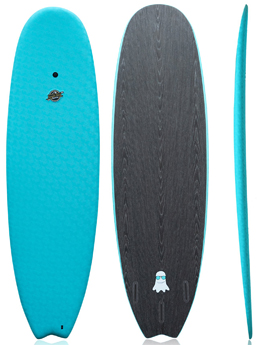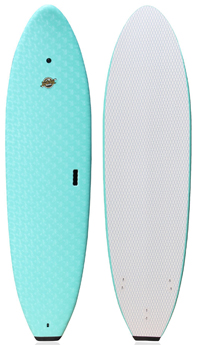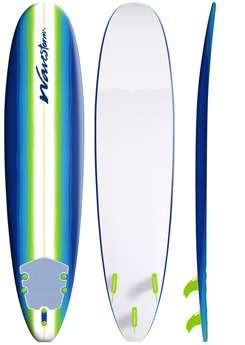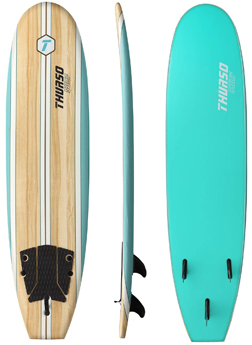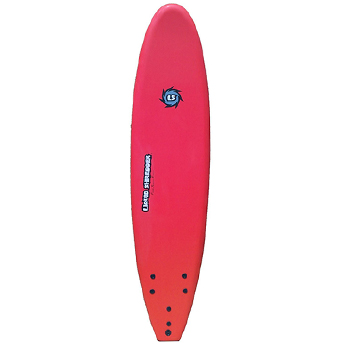Best Funboard Surfboard
These supersized shortboards in the 6'6" to 8' range, are great for beginners and more experienced surfers alike, depending on the model. You can’t go too far wrong when buying a funboard, but making the best possible choice of boards requires more careful consideration.
All fun boards are not equal, and the amount of difference between some models almost puts them in different categories altogether. Some are designed to help beginners catch waves, while others are aimed more at intermediates trying to improve their turns, or even advanced riders who want to have a good time even in bad conditions.
Don't go flashing cash in your local surf shop until you've had a chance to compare some of the best funboards, compiled and compared here in my round-up of the 5 best sticks.
Quick Glance:
#1 Best for performance - SBBC Casper 6'8" →
#2 Best for kids - SBBC Ruccus 7' →
#3 Best for beginners - Wavestorm 8' →
#4 Best for intermediates - THURSO SURF Aero 7' →
#5 Best for a bargain - Liquid Shredder 7' →
More...
Contents
The 5 Best Funboard Surfboards
#1 Best for performance - SBBC Casper 6'8"
South Bay Board Co. market the 6'8" x 21" x 2.75", 58L Casper hybrid surfboard as combining the best characteristics of funboards and true shortboards.
I have to agree they've done a great job in that regard.
Despite being shorter than the other boards in this review, the 6'8" Casper funboard's wide outline keeps enough foam under the surfer's chest to make paddling much easier than on a true shortboard.
At the same time, the pulled-in swallow tail lets the board turn freely, giving a shortboard feel to the ride.
This is an ideal choice for experienced or intermediate surfers who want a funboard so they can make the most of summer wave conditions.
The loose, shortboard feel is backed up by quality construction and features which will also appeal to someone more used to riding a fiberglass board. The EPS foam core may be a bit of an industry-standard these days, but an I-beam stringer and fiberglassed wood base are nice touches and I'm particularly pleased the thruster fin system uses Futures boxes. You can customize your ride by experimenting with different fin sets or by switching to twin fins, which are a great match for a similar tail to most fish surfboards. Topped off with a "fingerprint" patterned deck which doesn't need waxing, and the premium label is well earned.
Overall, the Casper funboard is possibly not the best choice for those at the absolute beginner stage, but surfers with a higher experience level will love it.
Pros & Cons
#2 Best for kids - SBBC Ruccus 7'
At 7' x 22" x 2.75", the Ruccus by South Bay Board Co is a true funboard, but you'll still find it has more refined features than most.
The dimensions don't tell the whole story as, far from being chunky, the thickness tapers out to shaped rails, resulting in a volume of just 49L.
This makes the Ruccus a perfect perfect learner board for kids, whilst an improving adult would find this funboard a good "next step".
Even for experienced surfers, there's a lot of enjoyment to be had from one of these; I'm surprised just how loose the board feels once you get onto the back foot.
The construction is not quite as exceptional as on the 6'8 Casper but it still comes into the premium category.
There are two wood and one fiberglass rod stringer reinforcing the EPS core, which is covered with the same patterned traction foam as other SBBC boards. The protective HDPE bottom deck is fitted with an FCS thruster fin system, which isn't quite as durable as Futures but does allow a similar range of options to play with. I also like the protective rubber tail block, it definitely helps prevent damage between sessions.
Overall, the Ruccus is absolutely ideal for the smaller riders it's designed for. That said, buy one for your kids and I guarantee you'll be "borrowing" it from time to time.
Pros & Cons
#3 Best for beginners - Wavestorm 8'
At a whopping 86L, this 8' x 22.5" x 3.25" Wavestorm is one of the best-selling beginner boards around.
If you haven't seen one of these in action before it's only a matter of time.
Learners love the buoyancy and stability of these soft top boards, and they're hardly going to break the bank either.
For those who've been surfing a while, this Wavestorm is going to feel much more familiar to a longboarder than someone who's used to high-performance surfing.
In fact, even I can get my toes pretty close to the nose with relative ease and I really don't have much experience with longboards at all.
Made simply but built for strength this board uses a similar EPS foam in the core to the South Bay Board Co surfboard designs, with three marine-ply stringers, an HDPE base, and a textured waterproof skin. Aside from the built-in traction pad, however, the surface gets slippery in the water and you will need to use wax if you want enough traction to surf without losing your footing.
Overall a good choice for new riders, longboarders, or anyone who wants to surf on days with a foot or less of swell.
Pros & Cons
#4 Best for intermediates - THURSO SURF Aero 7'
The 7' x 21.5" x 2.75" Aero from surf and SUP brand Thurso Surf, has a similar shape to the SBBC Casper, only slightly scaled up and using a squash tail instead of swallow.
A full rounded nose and rails for stability, pulled in far enough to the tail to give a reasonable tight turn radius, make this a good alternative for those who want similar characteristics on a tighter budget.
Another funboard better suited to the intermediate market than new learners, the balance of these board shapes is more towards turns than stability, although it's hardly a toothpick so anyone with more than a few surf sessions under their belt should be fine.
The Aero is built in similar materials to the Wavestorm, down to the triple wood stringers, HDPE bottom deck, and built-in traction pad.
Also like the 8'er, the IXPE deck surface also needs a good coat of wax to keep your front foot steady.
Bolt throughs aren't my favorite fin system but these are at least adjustable, with positioning options for the side fins which allow some adjustment of the ride quality.
Overall, this Thurso Surf funboard is a solid choice. It may not have quite the finesse of a more expensive South Bay Board Co board but it's solid, performs well, and for intermediates the difference is minimal.
Pros & Cons
#5 Best for a bargain - Liquid Shredder 7'
The 7' x 20" x 2.75" Liquid Shredder is very much the budget option out of the bunch.
The aim of this beginner board is to give affordable, no-frills fun for those new to surfing, and it does exactly that.
A slightly narrower design to some other funboard surfboards doesn't affect stability much because the full foam thickness is maintained all the way out to full rails.
However, it does help the board to hold its line and go where the surfer points it, although turning is compromised somewhat.
Surfers at intermediate or advanced experience level will find this more of an issue than beginners, so I'd strongly suggest they dig a little deeper in their pockets and opt for one of the South Bay Board Co options.
The construction is simple, using an EPS core, wooden stringers, PP slick base, and an EPE deck covering. In terms of accessories, the board comes complete with a leash and bolt-through fins, so it's basically ready to go right out of the box. The cheaper materials do affect durability though, and these do have a tendency to get creased more easily than the more premium options already listed.
The thing with beginner boards though, is you won't be a beginner for long. There's nothing wrong with picking up a bargain, riding it until it's worn out, then choosing a more refined option for the next step up on your surfing journey.
Pros & Cons
FAQ
Is a Funboard good for beginners?
It largely depends on the design. Some of the soft top funboards I've reviewed are very much designed for the beginner market, whereas others are better suited to intermediates and above. The best funboard surfboards for beginners are toward the upper end of the size range. The usual saying is "More foam means more fun!" meaning learners will catch waves more easily, fall less often, and improve faster if they choose a board with extra length and volume. Something like the Thurso Surf Aero 7' or the Wavestorm 8' would be ideal.
What size Funboard should I get?
The ideal size for you comes down to the question of why you are buying a funboard surfboard in the first place. If you're new to wave surfing, the best beginner options are around 8' long, with plenty of volume and a full outline, so they're easy to paddle and stable on the wave. However, more experienced surfers will get better performance out of models which are closer in dimensions to their shortboards, such as the 6'8" Casper I've included in my review.
What is the best surfboard for an intermediate surfer?
A funboard surfboard is an ideal choice for improving intermediate surfers. They're easier to paddle into waves and more forgiving than a high-performance shortboard, but still maneuverable enough for you to practice improving your turns, wave positioning, etc. Aim for a model 6" to 1' longer than your height and you won't go far wrong. It's also worth paying a slightly higher price than for your first beginner surfboard. You'll probably be in this stage for a couple of years so quality and durability are worth the extra expense.
Is a 7ft surfboard good for beginners?
Most beginners will find a 7' soft top funboard has plenty of buoyancy and stability to get them up and riding. They aren't quite as forgiving as true longboards, and a larger adult over 200lbs might want to start out with something bigger (see my review of the Wavestorm 8') but after a few sessions, even they should be able to catch waves on a 7' without too much difficulty. The advantage these have over larger boards mainly comes at the "improver" stage, when you are riding the wave face and want to learn to turn the board more.
Who Is A Funboard Perfect For?
A funboard can be perfect for anyone! Beginners choose them because they're stable and easy to paddle, while more experienced shortboard riders like to play around on funboards during weak summer swells which aren't suitable for their high-performance shortboards. The longer funboard surfboards are also a great intermediate step for surfers who want to make the transition from shortboards to longboards.
It's rare for an experienced surfer to have one of these as their only board or "daily driver", but there's certainly a place for one in pretty much everyone's quiver.
Funboard Pros & Cons
What To Consider When Buying A Funboard
As discussed in the individual reviews and FAQs, the types of funboard you want to look at are very much dependent on your level and current goals. Bigger is better for a beginner, and for novice learners I recommend 8' ideally. Whereas, something in a shorter, looser egg shape such as the 6'8 Casper will allow intermediates to improve their style and give experts the closest experience to their usual high-performance surfing.
Soft top funboard surfboards also come in quite a broad price range. One of the most important considerations in my book is how long you intend to be using the board.
If it's your first purchase as a beginner or you're using a funboard as a transitional step towards riding shortboards, it probably makes sense to keep the cost down and go for one of the budget options in your size range. On the other hand, if this is to be a permanent addition to your quiver, aimed at surfing summer conditions (or just a bit of extra soft top safety when the lineup gets crowded), the extra features and durability you can get by spending a bit more are well justified.
At the end of the day, funboards (as the name suggests) are all about squeezing maximum fun out of each session. If you're not sure quite what you want, err on the larger side for ease and wave count, and look for a balance of value and durability in the construction.

Jasmine Oneill Martin // Team Writer
